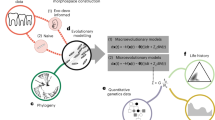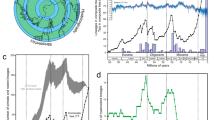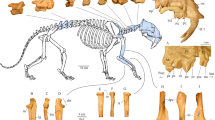Abstract
Analysis of dental morphology in over 600 stratigraphically controlled specimens of tarsier-like primates from early Eocene strata in the Bighorn Basin, Wyoming, provides important new data for understanding the tempo and mode of evolution in primates. Here we describe two evolutionary transitions at the generic level in separate lineages of the family Omomyidae. In both lines transformation occurred not only continuously (rather than by abrupt appearance of new morphologies followed by stasis), but also in mosaic fashion, with greater variation in certain characters preceding a shift to another character state. In one lineage this resulted in a significant change in dental adaptation. These data support a gradual model of dental evolution and are inconsistent with the punctuated equilibria model. Together with other reported cases, the data suggest that gradualism is much more prevalent than proponents of punctuated equilibria have argued.
This is a preview of subscription content, access via your institution
Access options
Subscribe to this journal
Receive 51 print issues and online access
$199.00 per year
only $3.90 per issue
Buy this article
- Purchase on Springer Link
- Instant access to full article PDF
Prices may be subject to local taxes which are calculated during checkout
Similar content being viewed by others
References
Gingerich, P. D. Nature 248, 107–109 (1974).
Gingerich, P. D. Am. J. Sci. 276, 1–28 (1976).
Gingerich, P. D. A. Rev. Earth planet. Sci. 8, 407–424 (1980).
Gingerich, P. D. & Simons, E. L. Contr. Mus. Paleont, Univ. Mich. 24, 245–279 (1977).
Gingerich, P. D. & Gunnell, G. F. Contr. Mus. Paleont. Univ. Mich. 25, 125–153 (1979).
Bookstein, F. L., Gingerich, P. D. & Kluge, A. G. Paleobiology 4, 120–134 (1978).
Bown, T. M. Mem. geol. Surv. Wyo. 2, 1–151 (1979).
Bown, T. M. & Kihm, A. J. J. Paleont. 55, 257–270 (1981).
Rose, K. D. Univ. Mich. Pap. Paleont. 26, 1–197 (1981).
Schankler, D. M. Nature 293, 135–138 (1981).
Gould, S. J. & Eldredge, N. Paleobiology 3, 115–151 (1977).
Stanley, S. M. Macroevolution (Freeman, San Francisco, 1979).
Bown, T. M. Folia primatol. 25, 62–72 (1976).
Bown, T. M. Univ. Wyo. Contr. Geol. 13, 19–26 (1974).
Jepsen, G. L. Proc. Am. phil. Soc. 69, 117–131 (1930).
Cope, E. D. Proc. Am. phil. Soc. 20, 139–197 (1882).
Matthew, W. D. Bull. Am. Mus. nat. Hist. 34, 429–483 (1915).
Simons, E. L. Primate Evolution (Macmillan, New York, 1972).
Szalay, F. S. Bull. Am. Mus. nat. Hist. 156, 157–450 (1976).
Gingerich, P. D. J. hum. Evol. 10, 345–374 (1981).
Szalay, F. S. & Delson, E. Evolutionary History of the Primates (Academic, New York, 1979).
Szalay, F. S. Folia primatol. 37, 153–162 (1982).
Schankler, D. M. Univ. Mich. Pap. Paleont. 24, 99–114 (1980).
Savage, D. E., Russell, D. E. & Waters, B. T. Géobios Mém. spéc. 1, 159–164 (1977).
Gazin, C. L. Smithson. misc. Collns 144, no. 1, 1–98 (1962).
Savage, D. E., Waters, B. T. & Hutchison, J. H. in Field Conference on Tertiary Biostratigraphy of Southern and Western Wyoming (ed. West, R. M.) (1972).
Eldredge, N. & Gould, S. J. in Models in Paleobiology (ed. Schopf, T. J. M.) (Freeman, San Francisco, 1972).
Vrba, E. S. S. Afr. J. Sci. 76, 61–84 (1980).
Stebbins, G. L. Evolution 36, 1109–1118 (1982).
Mayr, E. Evolution 36, 1119–1132 (1982).
Schopf, T. J. M. Evolution 36, 1144–1157 (1982).
Levinton, J. S. & Simon, C. M. Syst. Zool. 29, 130–142 (1980).
Williamson, P. G. Nature 293, 437–443 (1981).
Stanley, S. M. Evolution 36, 460–473 (1982).
Charlesworth, B., Lande, R. & Slatkin, M. Evolution 36, 474–498 (1982).
Ozawa, T. Mem. Fac. Sci. Kyushu Univ., ser. D. Geol. 23, 117–164 (1975).
Dzik, J. & Trammer, J. Acta palaeont. pol. 25, 55–89 (1980).
Malmgren, B. A. & Kennett, J. P. Paleobiology 7, 230–240 (1981).
Author information
Authors and Affiliations
Rights and permissions
About this article
Cite this article
Rose, K., Bown, T. Gradual phyletic evolution at the generic level in early Eocene omomyid primates. Nature 309, 250–252 (1984). https://doi.org/10.1038/309250a0
Received:
Accepted:
Issue Date:
DOI: https://doi.org/10.1038/309250a0
This article is cited by
-
Modules and Mosaics in the Evolution of the Tetonius – Pseudotetonius Dentition
Journal of Mammalian Evolution (2020)
-
Using extant patterns of dental variation to identify species in the primate fossil record: a case study of middle Eocene Omomys from the Bridger Basin, southwestern Wyoming
Primates (2008)
-
Early Eocene Cantius torresi—oldest primate of modern aspect from North America
Nature (1986)
Comments
By submitting a comment you agree to abide by our Terms and Community Guidelines. If you find something abusive or that does not comply with our terms or guidelines please flag it as inappropriate.



